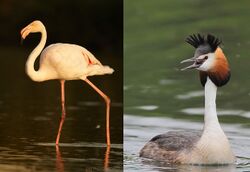Biology:Mirandornithes
| Mirandornithes | |
|---|---|

| |
| Greater flamingo (Phoenicopterus roseus) and great crested grebe (Podiceps cristatus) | |
| Scientific classification | |
| Domain: | Eukaryota |
| Kingdom: | Animalia |
| Phylum: | Chordata |
| Class: | Aves |
| Clade: | Neoaves |
| Clade: | Mirandornithes Sangster, 2005 |
| Subclades | |
| |
| Synonyms[3] | |
| |
Mirandornithes[4] (/mɪˌrændɔːrˈnɪθiːz/) is a clade that consists of flamingos and grebes. Many scholars use the term Phoenicopterimorphae for the superorder containing flamingoes and grebes.[5][6]
Determining the relationships of both groups has been problematic. Flamingos had been placed with numerous branches within Neognathae, such as ducks and storks. The grebes had been placed with the loons. However recent studies have confirmed these two branches as sister groups.[6][7][8][9][10][11][12]
Both primitive phoenicopteriformes and their closest relatives, the grebes, were highly aquatic.[13] This indicates that the entire mirandornithe group evolved from aquatic, probably swimming ancestors.[9]
Etymology
The term was coined by Sangster in 2005, in order to properly describe the new clade discovered with molecular analyses. It is inspired by the latin miranda, meaning "wonderful", and the greek ορνιζ (ornis), meaning bird.[4]
Synapomorphies
According to Mayr (2004) and Sangster (2005) there are at least twelve distinct morphological synapomorphies that are unique to this clade:[4]
- "At least the fourth to seventh cervical vertebrae strongly elongate, with processus spinosus forming a marked ridge.
- Humerus with a marked oval depression at insertion site of musculus scapulohumeralis cranialis.
- At least 23 presacral vertebrae.
- At least four thoracic vertebrae fused to a notarium.
- Distal end of ulna with marked oval depression radialis.
- Phalanx proximalis digiti majoris very elongate and narrow craniocaudally.
- Distal rim of condylus medialis of tibiotarsus distinctly notched.
- Pars acetabularis of musculus iliotibialis lateralis absent.
- Pars caudalis of musculus caudofemoralis absent.
- Wing with 12 primaries
- Left arteria carotis reduced or absent.
- Eggs covered with a chalky layer of amorphous calcium phosphate."
References
- ↑ Švec, P. 1982. Two new species of diving birds from the lower Miocene of Czechoslovakia. Časopis pro mineralogii a geologii, 27, 243–260.
- ↑ Kuhl., H.; Frankl-Vilches, C.; Bakker, A.; Mayr, G.; Nikolaus, G.; Boerno, S. T.; Klages, S.; Timmermann, B. et al. (2020). "An unbiased molecular approach using 3'UTRs resolves the avian family-level tree of life.". Molecular Biology and Evolution 38: 108–127. doi:10.1093/molbev/msaa191. PMID 32781465.
- ↑ Sangster, G.; Braun, E.L.; Johansson, U.S.; Kimball, R.T.; Mayr, G.; Suh, A. (2022). "Phylogenetic definitions for 25 higher-level clade names of birds". Avian Research 13: 100027. doi:10.1016/j.avrs.2022.100027. Bibcode: 2022AvRes..1300027S.
- ↑ 4.0 4.1 4.2 Sangster, G. (July 2005). "A name for the flamingo-grebe clade". Ibis 147 (3): 612–615. doi:10.1111/j.1474-919x.2005.00432.x.
- ↑ Joel Cracraft (12 December 2014). "Justifications of names for higher taxa". Science 346 (6215): 1320–1331. doi:10.1126/science.1253451. PMID 25504713. Bibcode: 2014Sci...346.1320J.
- ↑ 6.0 6.1 Jarvis, E.D. (12 December 2014). "Whole-genome analyses resolve early branches in the tree of life of modern birds". Science 346 (6215): 1320–1331. doi:10.1126/science.1253451. PMID 25504713. Bibcode: 2014Sci...346.1320J.
- ↑ Tuinen, Van; Butvill, M.; Kirsch, D.B.; Hedges, S.B. (7 July 2001). "Convergence and divergence in the evolution of aquatic birds". Proc. R. Soc. B 268 (1474): 1345–1350. doi:10.1098/rspb.2001.1679. PMID 11429133.
- ↑ Chubb, A.L. (January 2004). "New nuclear evidence for the oldest divergence among neognath birds: The phylogenetic utility of ZENK (i)". Molecular Phylogenetics and Evolution 30 (1): 140–151. doi:10.1016/S1055-7903(03)00159-3. PMID 15022765.
- ↑ 9.0 9.1 Mayr, G. (February 2004). "Morphological evidence for sister group relationship between flamingos (Aves: Phoenicopteridae) and grebes (Podicipedidae)". Zoological Journal of the Linnean Society 140 (2): 157–169. doi:10.1111/j.1096-3642.2003.00094.x.
- ↑ Fain, M.G. Houde (November 2004). "Parallel radiations in the primary clades of birds". Evolution 58 (11): 2558–2573. doi:10.1554/04-235. PMID 15612298.
- ↑ Ericson, J.I.; Anderson, P.G.P.; Britton, C.L.; Elzanowski, T.; Johansson, A.; Kllersj, U.S.; Ohlson, M.; Parsons, T.J. (22 December 2006). "Diversification of Neoaves: integration of molecular sequence data and fossils". Biology Letters 2 (4): 543–547. doi:10.1098/rsbl.2006.0523. PMID 17148284.
- ↑ Hackett, S.J. (27 June 2008). "A phylogenomic study of birds reveals their evolutionary history". Science 320 (5884): 1763–1768. doi:10.1126/science.1157704. PMID 18583609. Bibcode: 2008Sci...320.1763H.
- ↑ Mayr, G. (2014) The Eocene Juncitarsus – its phylogenetic position and significance for the evolution and higher-level affinities of flamingos and grebes. Comptes Rendus Palevol. 13(1):9-18. https://doi.org/10.1016/j.crpv.2013.07.005
Wikidata ☰ Q5891686 entry
 |

